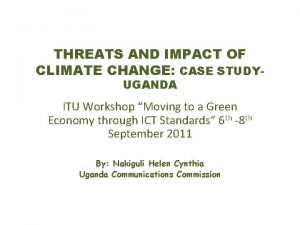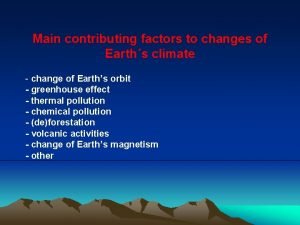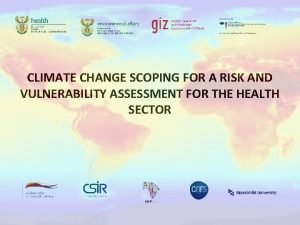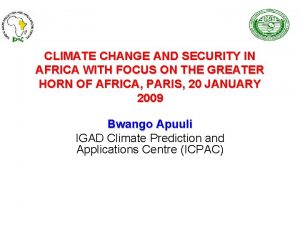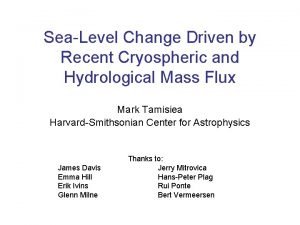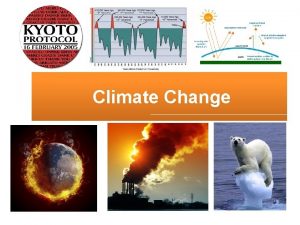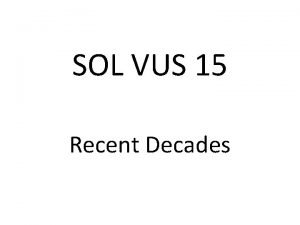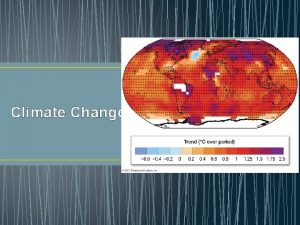Recent decades of climate and cryospheric change on































- Slides: 31

Recent decades of climate and cryospheric change on the Antarctic Peninsula David G. Vaughan British Antarctic Survey

Climate Warming - Antarctica Source: Vaughan et al. Climatic Change, 2002

Antarctic Peninsula melt - Mean annual air temp

Part 1 - More melt… Vaughan, D. G. , 2006: Recent trends in melting conditions on the Antarctic Peninsula and their implications for ice-sheet mass balance. Arctic, Antarctic and Alpine Research, 38(1), pp. 147 -152.

Faraday/Vernadsky mean annual temperature Source: BAS

Faraday/Vernadsky – seasonal trends Source: BAS

Antarctic Peninsula Fossil Bluff 1985/86 Fossil Bluff 1996/97 Source: DGV

…quantitative – Rothera ramp Source: Andy Smith

Antarctica Peninsula - orientation

Annual PDDs

Antarctic Peninsula melt - Station trends

Parameterisation of ann. temp vs. PDDs Figure 3. Correlation of mean annual air temperature to positive degree-days for all Antarctic Peninsula station data. East coast sites are represented by open circles and have a best fit regression line (solid) of, Φ = 1089 e (0. 261 T / ˚C) (r 2 = 0. 84). West coast sites are represented by black triangles and have a best-fit regression line (dashed) of, Φ = 358 e (0. 251 T / ˚C) (r 2 = 0. 79).

Melt-day distribution 2000 1950 2050 Figure 4. Distribution of annual positive degree-days calculated for a. 1950 (i. e. 2000 – 2. 5˚C), b. 2000 and c. 2050 (i. e. 2000 – 2. 5˚C).

Antarctic Peninsula melt - Mass balance and runoff

Conclusions • Parameterization of the number of PDDs as a function of mean annual temperature allows mapping of change • Increasing surface ablation was estimated and shown to be likely to have doubled between 1950 and 2000, and given continued summer warming could double or treble by 2050. • Runoff was calculated. At present it is (0. 008 - 0. 055) mm a-1 of sea level rise with the likelihood that with continued warming it will perhaps treble within 50 years. Increasing uncertainty • Long-term meteorological station data show increased duration of melt conditions across the Antarctic Peninsula over the past 50 years

Part 2 - Shortening glaciers… Cook, A. J. Fox, D. G. Vaughan, and J. G. Ferrigno, 2005: Retreating glacier-fronts on the Antarctic Peninsula over the last 50 years. Science, 22, pp. 541 -544.


Sheldon Glacier 1957 1986 1969 1998 2001

Analysis of glacier-front changes 1970 - 1975 -1980 - 1985 -1990 - 19951974 1979 1984 1989 1994 1999 Extract from table showing mean change per year observed in 5 -year intervals

Change in glacier length

Complete population

Latitude Sectors

Part 3 - Faster glaciers… H. Pritchard and D. G. Vaughan, in prep.

Tracking features in radar (SAR) images SAR 1 +35 days measurement = (glacier flow) & (orbit offset) random error systematic error SAR 2

Tracking error: the case for azimuth-direction data 2) range azimuth Range direction Azimuth direction 1) 1 5

Tracking features in radar (SAR) images • 150 scenes • 70 000 km 2 • 337 glaciers • 9 summers 0 0 md-1 15 4 30

Change in flow speed 1993 to 2003 Change in flow speed % that accelerated +7. 8 % 60% +14. 2 % 65% +14. 4 % 65% +12. 7 % 67% +13. 4 % 75% (± 0. 5 to 0. 7%) (by > 5%)

Retreat rate +8% 64 °S +14% 10 % +14% +13% 68 °S Cook et al. (2005) 0

Conclusions • Significant, widespread speed-up • Appears driven by retreat • Response to strong regional warming

Conclusions Antarctic Peninsula contribution to sea level: AP runoff: Shelf collapse (Rignot et al. 2004): up to AP flow imbalance (12%, 1993 -2003): at least 0. 06 mm /yr Total: Alaska melt (Arendt et al. 2002): 0. 06 mm /yr 0. 07 mm /yr 0. 19 mm /yr 0. 14 mm/yr

Conclusions
 Climate change 2014 mitigation of climate change
Climate change 2014 mitigation of climate change Decades project
Decades project Last decades art
Last decades art One step forward two decades back
One step forward two decades back Climate change meaning
Climate change meaning Chapter 13 atmosphere and climate change section 1
Chapter 13 atmosphere and climate change section 1 Chapter 13 atmosphere and climate change
Chapter 13 atmosphere and climate change Persuasive essay about global warming
Persuasive essay about global warming Karnataka state action plan on climate change
Karnataka state action plan on climate change Brainpop climate types
Brainpop climate types Unit 9 climate change
Unit 9 climate change Conclusion of climate change
Conclusion of climate change Conclusion of climate change
Conclusion of climate change Conclusion of climate change
Conclusion of climate change Mathematics of climate change
Mathematics of climate change Globalization definition ap world history
Globalization definition ap world history Climate change mitigation
Climate change mitigation Pc 414
Pc 414 Conclusion of climate change
Conclusion of climate change Factors of climate change
Factors of climate change Human causes of climate change
Human causes of climate change Framework sample
Framework sample Uk climate change
Uk climate change Climate change interview
Climate change interview Factors effecting climate change
Factors effecting climate change Conclusion of climate change
Conclusion of climate change Conclusion of climate change
Conclusion of climate change Climate change causing droughts
Climate change causing droughts How to reduce climate change
How to reduce climate change How global warming works
How global warming works Financing education in a climate of change
Financing education in a climate of change Climate change pathos
Climate change pathos













